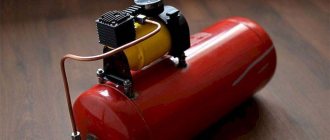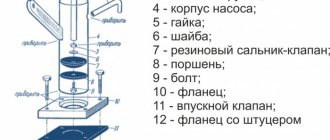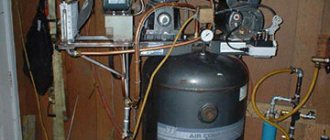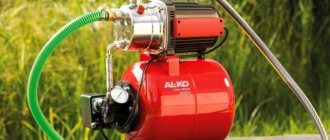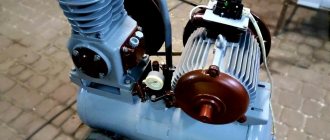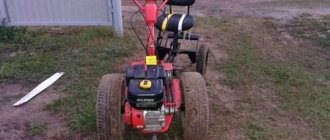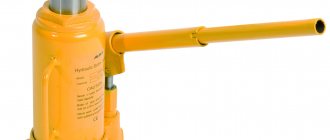June 08, 2020
- Oil compressors
- Pros and cons of rotary type compressors
Air compressors are complex machines whose main job is to compress air or other gases. Their alternative name is compressed air receivers. Compressed air is consumed by a pneumatic tool or can be used directly from a compressor using a hose.
To select and use this equipment correctly, you need to understand the principles of its operation. Below we will talk in detail about the types of compressor units, their design and how they work.
Application area of air compressors
Air compressors are widely used in many areas of human activity. These devices are indispensable when carrying out installation, carpentry, construction and repair work. Aircraft are also successfully used in everyday life. For example, a household unit can be used for inflation of tires, painting, airbrushing, etc. As a rule, this is a compressor with an electric motor operating from a 220 V network. For professional use, a rotary oil unit, which has an increased service life and does not require frequent maintenance, is better suited.
Air compressors are also in high demand in the industrial sector, in industries that require the use of compressed air.
There are devices with a high degree of air purification. They are used in “clean” industries, for example, in the chemical, pharmaceutical and food industries, as well as in the electronics industry.
In addition, air compressors have found application in the oil and gas industries, in the mining industry, in coal and stone mining.
Top 3 best models
In the review of the best brands and models presented on the Russian market, we can note domestic products, as well as products from Ukrainian (for example, Dnipro-M), Belarusian and Chinese (for example, Steel KST-50) manufacturers. To help you navigate the variety of choices for this equipment, here are the top three ratings for 2022 in different categories.
- VORTEX KMP-300/50 is one of the best domestically produced oil devices with direct electric drive, the productivity of which reaches 300 liters. Its rated power is 2 kW, the receiver is 50 liters. These indicators are sufficient for use in everyday life, private workshops and even in small industries. Additional advantages: pressure regulator, circuit that protects against overheating, low weight (20 kg) and transport wheels. The model can be bought very inexpensively (up to 10 thousand rubles).
- The Belarusian air compressor REMEZA VK20T-15-500 has unique capabilities. It is a group of professional oil-free equipment with the best power (15 kW) and pressure (15 bar). Model characteristics: three-phase electric motor with a service life of 15-20 years, receiver – 500 l, noise level – 77 dB.
- Among the compressors of Western brands, it is worth noting the two-piston (two-cylinder) unit of the Fubag VCF 50 CM 3 brand from German manufacturers. Its characteristics: electric motor power – 2.2 kW, operating pressure – 9 atm., productivity – 300 l, power supply – 200V network, there is a receiver and 2 pressure gauges. The unit is equipped with systems: protection against overheating and automatic restart. The sample is manufactured using high technologies and the latest developments, allowing it to be used in fairly harsh conditions, as well as making the design as simple as possible for operation and maintenance.
How an air compressor works and works
The design of the air compression unit is determined by the type of construction. Compressors are piston, rotary and membrane. The most widely used are piston air units, in which air is compressed in a cylinder due to the reciprocating movements of the piston inside it.
Device diagram
The design of an air piston compressor is quite simple. Its main element is the compressor head. Its design is similar to the cylinder of an internal combustion engine (ICE). Below is a diagram of the piston unit, which clearly shows the structure of the latter.
The compressor unit includes the following elements.
- Cylinder. This is the volume in which air is compressed.
- Piston. By reciprocating movements it sucks air into the cylinder or compresses it.
- Piston rings. Installed on the piston and designed to increase compression.
- Connecting rod. Connects the piston to the crankshaft, transmitting reciprocating movements to it.
- Crankshaft. Thanks to its design, it allows the connecting rod to move up and down.
- Inlet and discharge valves. Designed for inlet and outlet of air from the cylinder. But compressor valves are different from internal combustion engine valves. They are made in the form of plates pressed by a spring. The opening of the valves is not forced, as in an internal combustion engine, but due to the pressure difference in the cylinder.
To reduce the friction force between the piston rings and the cylinder, oil is supplied to the compressor head. But in this case, the air leaving the compressor contains lubricant impurities. To eliminate them, a separator is installed on the piston apparatus, in which the mixture is separated into oil and air.
If special purity of compressed air is required, for example, in medicine or electronics production, then the design of the piston unit does not imply the use of oil. In such devices, the piston rings are made of polymers, and graphite lubricant is used to reduce the friction force.
Piston units may have 2 or more cylinders arranged in a V-shape. Due to this, the productivity of the equipment increases.
The crankshaft is driven by an electric motor via a belt or direct drive. With a belt drive, the design of the device includes 2 pulleys, one of which is installed on the motor shaft, and the second on the shaft of the piston block. The second pulley is equipped with blades for cooling the unit. In the case of direct drive, the shafts of the motor and the piston unit are connected directly and are on the same axis.
Also, the design of a piston compressor includes another very important element - a receiver, which is a metal container. It is designed to eliminate pulsations of air leaving the piston block and works as a storage tank.
Thanks to the receiver, you can maintain the pressure at the same level and distribute air evenly. For safety, an emergency relief valve is installed on the receiver, which is triggered when the pressure in the tank rises to critical values.
In order for the compressor to operate in automatic mode, a pressure switch (pressostat) is installed on it. When the pressure in the receiver reaches the required values, the relay opens the contact and the engine stops. And vice versa, when the pressure in the receiver decreases to the set lower limit, the pressure switch closes the contacts and the unit resumes operation.
Operating principle
The operating principle of a piston compressor can be described as follows.
- When the engine starts, the crankshaft begins to rotate, transmitting reciprocating movements through the connecting rod to the piston.
- The piston, moving downwards, creates a vacuum in the cylinder, under the influence of which the intake valve opens. Due to the difference in air pressure, it begins to be sucked into the cylinder. But before entering the compression chamber, the air passes through a cleaning filter.
- Next, the piston begins to move upward. In this case, both valves are in a closed state. At the moment of compression, the pressure in the cylinder begins to increase, and when it reaches a certain level, the exhaust valve opens.
- After opening the exhaust valve, compressed air is directed to the receiver.
- When a certain pressure is reached in the receiver, the pressure switch is activated and air compression is suspended.
- When the pressure in the receiver drops to the set values, the pressure switch starts the engine again.
Main manufacturers
To choose the right refrigeration equipment, you need to navigate its “contents”. And the main unit responsible for reliability, energy consumption and performance is the compressor.
The American company TECUMSEN is considered the leader in the production of piston crank models. Many factories in Europe and Asia operate under its licenses.
Among European manufacturers, the Italian concern EMBRACO sells the most compressor motors. The factories of this concern in Europe, Brazil and China produce about 20 million units per year, and they are installed on refrigerators from such a well-known manufacturer as LIEBHERR.
The ELECTROLUX concern owns several brands of refrigerators. The volume of our own production of motor-compressors reaches about 12 million units per year, and they are known under the following brands:
- Austrian Verdichter;
- Italian Zem;
- Spanish Unite Germetique;
- American Kelvinator.
The Danish company DANFOSS has a very good reputation. Its products are quite satisfactory for such reputable refrigerator manufacturers as the BOSCH and SIEMENS concerns.
Common faults and their solutions
Let's look at the main malfunctions in the operation of an air compressor that you can fix yourself.
The unit engine does not start
First of all, if the engine of the unit fails, you should make sure that there is voltage in the network. It is also a good idea to check the power cable for damage. Next, fuses are checked, which may blow out during a power surge. If any faulty cables or fuses are found, they should be replaced.
The pressure switch also affects engine starting. If it is incorrectly configured, the unit stops turning on. To check the operation of the relay, you need to bleed the air from the receiver and turn on the device again. If the engine starts, carry out the correct (according to the instructions) adjustment of the pressure switch.
In some cases, the engine may not start due to the thermal relay tripping. This usually happens if the unit operates intensively, almost non-stop. In order for the equipment to start working again, you need to give it some time to cool down.
The engine hums but does not start
The humming of the engine without rotating its rotor may be due to low voltage in the network, due to which it does not have enough power to start. In this case, the problem can be solved by installing a voltage stabilizer.
Advice! If the network “sags” due to the operation of any machine, for example, a welding machine, then it should be turned off while using the compressor.
Also, the engine is unable to crank the crankshaft if the pressure in the receiver is too high, and pumping resistance occurs. If this is the case, then you need to bleed the air from the receiver a little, and then adjust or replace the pressure switch. Increased pressure in the receiver can also occur if the relief valve is faulty. It must be removed and cleaned, and if damaged, replaced.
The air coming out has water particles
If the air leaving the receiver contains moisture, then it will not be possible to paint any surface efficiently. Water particles may be present in compressed air in the following cases.
- There is high humidity in the room where the unit operates. It is necessary to provide the room with good ventilation or install a dehumidifier on the compressor (see figure below).
- Water has accumulated in the receiver. It is necessary to regularly drain the water from the receiver through the drain valve.
- The water separator is faulty. The problem is solved by replacing this element.
Decrease in unit performance
The performance of the device may decrease if the piston rings burn out or wear out. As a result, the compression level decreases and the device cannot operate in standard mode. If this fact is confirmed when disassembling the cylinder, then the worn rings should be replaced.
Valve plates can also cause a drop in performance if they are broken or stuck. Faulty plates should be replaced, and clogged ones should be washed. But the most common reason that causes a loss of unit power is a clogged air filter, which should be washed regularly.
Compressor head overheating
The piston head may overheat if the oil is not changed in a timely manner or if a lubricant is used that does not correspond to what is specified in the passport. In both cases, the oil should be replaced with a special compressor oil with a viscosity, the value of which is indicated in the passport for the unit.
Also, overheating of the piston head can be caused by over-tightening the connecting rod bolts, which causes poor oil flow to the bearings. The malfunction is eliminated by loosening the connecting rod bolts.
Unit overheating
Normally, the unit may overheat when operating in intensive mode or at elevated ambient temperatures in the room. If, under standard operating mode and normal room temperature, the unit still overheats, then a clogged air filter may be the culprit. It should be removed and washed, and then dried well.
Advice! This procedure is recommended to be carried out regularly. If the unit is used intensively, the filter should be washed daily.
Knock in the cylinder
Caused by breakage or wear of the piston rings due to carbon deposits. It usually appears if you use low-quality oil.
Also, knocking in the cylinder can be caused by wear of the connecting rod head bushing or piston pin. To fix the problem, these parts should be replaced with new ones. If the cylinder and piston are worn out, air compressor repair involves boring the cylinder and replacing the piston.
Knock in the crankcase
The appearance of a knock in the crankcase during operation of the unit is caused by the following breakdowns.
- The connecting rod bolts are loose. It is necessary to tighten the bolts with the required force.
- The crankshaft bearings have failed. Bearings need to be replaced.
- The connecting rod journals of the crankshaft and connecting rod bearings are worn out. Elimination of these faults involves processing the connecting rod journals to repair size. The liners are also replaced with similar repair-sized parts.
Reduced pressure in the system when the power is turned off
The problem most often occurs due to leaks in one or several elements of the system . First of all, it is worth checking the outlet valve with the piston valve, and also inspect the entire line where the pressure is injected and maintained.
You can adopt an old proven method: lubricate problem areas with soapy water. An air leak will immediately make itself known by the appearance of bubbles. Any cracks that appear are sealed with any sealing material: preferably with a jelly-like consistency to prevent peeling.
The outlet valve is checked in the same way. If the solution bubbles when fixed in the off state, the part must be replaced. In this case, special attention must be paid to sealing: when installing a new faucet, it is imperative to wrap plumbing tape around the threads.
Important! Before carrying out repair work on the air line, it is necessary to bleed all the air in the system. Otherwise, you can not only get serious burns, but also damage the hoses with valves.
Sometimes, to normalize the pressure, it is enough to clean all moving elements - taps and valves from accumulated dirt.
Periodic activation of thermal protection sensors
The obvious reason for this effect is a very high room temperature or operation of the device in direct sunlight. If the climatic conditions are all right, then the problem may be due to insufficient voltage in the network.
Air cooled compressor
A multimeter will help to identify faults of this kind. When the ringing indicators are significantly lower than the standards established by the equipment manufacturer (indicated in the instructions for the device), then we supplement the circuit with a voltage stabilizer.
The engines in classic compressors are air cooled. If the room is poorly ventilated, the device will quickly heat up, and as a result, the thermal protection sensors will work. In this case, it is necessary to move the equipment to a place with sufficient ventilation. It would also be a good idea to check the air filter: clean it of accumulated dirt or replace it altogether.
Unstable engine operation
The problem may occur due to too intense air output or a malfunction of the pressure control sensor. If the power consumed by construction equipment does not correspond to the performance of the compressor, then a significant difference will always affect the operation of the engine.
Therefore, it is imperative to take into account the characteristics of a pneumatic tool, namely, the volume of air consumed per unit of time, and correlate them with the capabilities of the unit. The air flow for the equipment should not exceed 70% of the compressor output.
Pressure switch for compressor
If the technical characteristics of both devices comply with the standards, then the problem is with the pressure switch. The sensor can be repaired, but it is more practical to replace it: fortunately, it is inexpensive and is sold in almost every specialized store.
Increased air flow
First of all, you need to check the air filter: clean or replace if necessary. The next reason is a gas leak in the system. We check every centimeter of the highway, and especially the joints and connections. The latter are treated with sealing material and fum tape.
Some users, after cleaning the receiver from condensate, forget to fix the outlet valve. Sometimes, as a result of increased pressure, it goes down a couple of millimeters on its own: we pull it all the way and check the pressure in the system.
What to make a receiver from
The simplest receiver for a compressor intended for small volumes of work can be easily made from a tubeless car wheel. It should be taken into account that after modernization the wheel cannot be used for its original purpose.
If you need to make a compressor for large volumes of work, then it is recommended to use a gas cylinder or any type of fire extinguisher as a container.
Note!
DIY induction heater ♨️ - reviews of the best manufacturing options. Varieties of homemade device designs + step-by-step master class (160 photos)
Do-it-yourself Gauss cannon: TOP-130 photos of the best ways to create it yourself. Design features + master class for beginners
DIY clamps - a step-by-step master class for beginners. Schemes for manufacturing different designs + 170 photos
Compressor Maintenance
Periodic maintenance and following simple rules, which are indicated in the operating instructions for the device, will significantly increase the service life of the equipment. At the time of purchasing a compressor, you must make sure that you have a passport, a warranty card and a factory inventory of components. Otherwise, the service center may refuse service.
The general recommendations of equipment manufacturers and service center specialists sound like this.
- When starting the unit for the first time, we must check the oil using a dipstick. Select lubricant (technical composition) taking into account the operating instructions. After starting, let the engine run idle for 10-15 minutes.
- The oil is changed to a new one after 500 hours of operation (we keep a record book). After draining the waste, the container is cleared of accumulated dirt.
- Before using the tool, it is necessary to lower the pressure to normal if it is too high.
- The air filter should be cleaned at least once a week. Many manufacturers recommend changing it every quarter, especially when the equipment is actively used.
- At the end of each working day, it is necessary to drain the accumulated water from the receiver.
- At the end of the work, the air is bled off and the equipment is completely de-energized.
- When the compressor is idle for a long time, the platform and moving parts of the air valve must be lubricated.
- Keep the device clean. The entry of dirt into the system is fraught not only with a loss of pressure, but also with failure of the main components of the compressor.
Particular attention should be paid to equipment grounding for all non-current-carrying metal components. In a good half of cases, manufacturers output the corresponding conductor to the plug. All that remains is to ground the outlet itself where the device will be connected.
Operating procedure
- The refrigeration motor is equipped with three outputs. You need to mark the inlet and outlet holes for yourself. The sealed outlet is used to change engine oil. It needs to be cut off, drained of oil, filled with new oil (synthetic or semi-synthetic) and sealed.
- It is necessary to remove the outlet valve from the cylinder and remove the cap. The cylinder is cleaned of traces of corrosion and contamination from the outside and inside, and the lid is replaced. An adapter and a cross are placed in the lid.
- The upper pipe is intended for a pressure gauge and a tee. Another pipe is used to install a safety valve.
- Then you should make a frame for the device.
- The motor and receiver cylinder are attached to the base frame.
- Fuel filters should be connected to the inlet pipe.
- The wiring is done using a pressure switch, a toggle switch and a start relay. It is important to install the starting relay immediately in the correct position according to the mark.
- The tube through which air will be supplied must be connected to the receiver.
- Then you need to install a pressure gauge and a hose with a locking outlet.
Making a compressor from a refrigerator with your own hands is cost-effective and easy. The device does not make much noise during operation and is quite mobile. If regular movement is necessary, it is easy to equip the frame with wheels.
